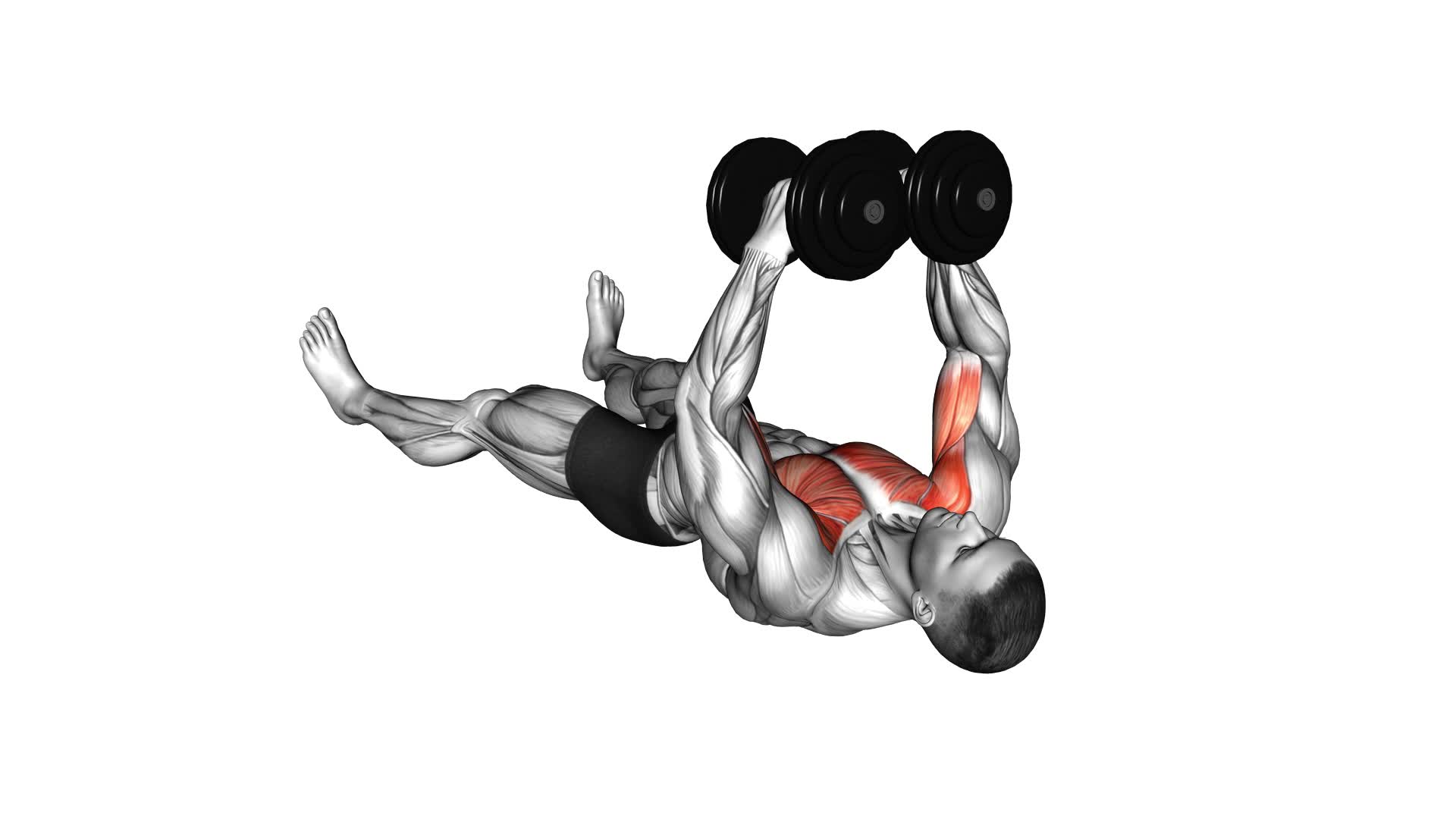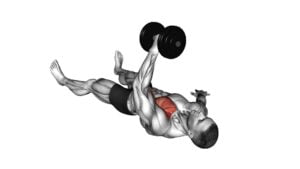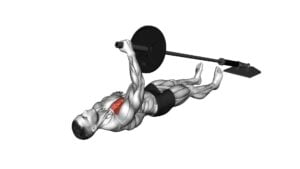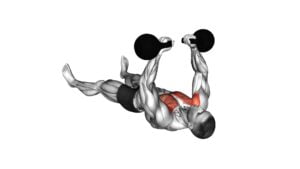Dumbbell Floor Fly – Video Exercise Guide & Tips

Are you looking for a challenging exercise to target your chest muscles? Look no further than the dumbbell floor fly.
Watch This Exercise Video
This exercise is a great way to strengthen and tone your chest while also engaging your shoulders and arms.
In this video exercise guide, you'll learn the proper form and technique for performing the dumbbell floor fly, as well as variations to challenge yourself.
Get ready to take your chest workout to the next level!
Key Takeaways
- The Dumbbell Floor Fly activates multiple muscles simultaneously and targets the pectoralis major, deltoids, triceps, and core muscles.
- It offers versatility for different fitness levels and goals, improving posture and shoulder stability.
- The exercise can be done with a pair of dumbbells on a flat surface, and alternative exercises include push-ups and chest presses with resistance bands.
- It is important to maintain proper form and technique, avoiding common mistakes such as using excessive weight, flaring elbows out, and using momentum to lift the dumbbells.
Benefits of the Dumbbell Floor Fly
Discover the numerous advantages you can gain from incorporating the Dumbbell Floor Fly into your fitness routine. This exercise offers a range of benefits, from increased muscle activation to improved upper body strength and stability.
One of the main benefits of the Dumbbell Floor Fly is its ability to activate multiple muscles simultaneously. This exercise primarily targets the pectoralis major, the main chest muscle, helping to build strength and definition in your chest. Additionally, the Dumbbell Floor Fly also engages the deltoids, triceps, and core muscles, providing a comprehensive upper body workout.
Another advantage of the Dumbbell Floor Fly is its versatility. This exercise can be easily modified to suit your fitness level and goals. By adjusting the weight of the dumbbells or the angle of your arms, you can increase or decrease the intensity of the exercise. This makes it suitable for beginners who are just starting their fitness journey, as well as advanced athletes looking to challenge themselves.
Incorporating the Dumbbell Floor Fly into your fitness routine can also help improve your posture and shoulder stability. This exercise strengthens the muscles that support your shoulders, reducing the risk of injuries and promoting proper alignment.
Equipment Needed for the Exercise
Now let's talk about what equipment you'll need for the Dumbbell Floor Fly exercise.
This exercise primarily requires a pair of dumbbells. Ideally, choose dumbbells that are challenging enough to provide resistance but still allow you to maintain proper form throughout the exercise. It's important to select a weight that suits your fitness level and goals.
In addition to the dumbbells, you'll also need a flat surface, such as a yoga mat or exercise mat, to perform the exercise comfortably. The mat provides cushioning and prevents any discomfort or strain on your back during the exercise.
If you don't have access to dumbbells, you can use alternative exercises to target the same muscles. Push-ups and chest presses with resistance bands are effective alternatives that can provide similar benefits. However, they may not specifically target the chest muscles as intensely as the Dumbbell Floor Fly exercise.
When performing the Dumbbell Floor Fly, common mistakes to avoid include using excessive weight, which can compromise your form and increase the risk of injury. It's important to focus on maintaining control and stability throughout the movement. Additionally, avoid flaring your elbows out and keep them slightly bent to prevent strain on the shoulder joints.
Proper Form and Technique
To perform the Dumbbell Floor Fly exercise with proper form and technique, ensure that you maintain control and stability throughout the movement. Start by lying flat on your back on the floor, holding a dumbbell in each hand with your arms extended straight above your chest. Bend your elbows slightly and lower your arms out to the sides, keeping them parallel to the floor. Maintain a slight bend in your elbows throughout the exercise to prevent any strain on your joints. As you lower your arms, exhale and focus on squeezing your chest muscles. Avoid letting your elbows drop too far below shoulder level, as this can put unnecessary stress on your shoulders. Keep your core engaged and your back flat against the floor to maintain stability.
Common mistakes to avoid when performing the Dumbbell Floor Fly include using weights that are too heavy, which can lead to improper form and potential injury. It's important to choose a weight that allows you to maintain control and perform the exercise with proper technique. Additionally, avoid using momentum to lift the dumbbells, as this takes away from the effectiveness of the exercise and reduces the activation of the targeted chest muscles.
The Dumbbell Floor Fly primarily targets the chest muscles, specifically the pectoralis major and pectoralis minor. However, it also engages the shoulders, triceps, and core muscles to a lesser extent. By performing this exercise correctly, you can effectively strengthen and tone your chest muscles.
Now that you understand the proper form and technique for the Dumbbell Floor Fly, let's explore some variations to challenge yourself and take your chest workout to the next level.
Variations to Challenge Yourself
To challenge yourself and further enhance your chest workout, you can incorporate different variations of the Dumbbell Floor Fly exercise. These advanced modifications will help you target your chest muscles in unique ways and take your workout to the next level.
One variation you can try is the Incline Floor Fly. This involves performing the exercise on an incline bench instead of the floor. The incline angle increases the difficulty and emphasizes the upper chest muscles.
Another alternative exercise is the Dumbbell Floor Press. Instead of performing a fly motion, you perform a pressing motion by extending your arms straight up. This variation targets the chest muscles in a different way and can help improve your upper body strength.
If you're looking for a challenge, you can also try the Single-Arm Floor Fly. This variation involves performing the exercise with one arm at a time, which increases the demand on your stabilizer muscles and improves balance and coordination.
Incorporating these advanced modifications and alternative exercises into your routine won't only challenge your chest muscles in new ways but also help prevent plateaus and keep your workouts interesting and effective. Remember to start with lighter weights and gradually increase the load as you become more comfortable with the variations.
Tips for a Safe and Effective Workout
How can you ensure a safe and effective workout? Here are some tips and techniques to help you get the most out of your fitness routine while minimizing the risk of injury.
First and foremost, it's essential to warm up properly before starting any workout. This can include dynamic stretches, light cardio exercises, and foam rolling to loosen up your muscles and increase blood flow. Warming up prepares your body for the upcoming physical activity and reduces the likelihood of strains or sprains.
Next, pay attention to your form and technique during exercises. Proper form is crucial for targeting the right muscles and avoiding unnecessary strain on joints and ligaments. Take the time to learn the correct form for each exercise and focus on maintaining it throughout your workout.
Another important tip is to listen to your body. If something doesn't feel right or if you experience pain, stop the exercise and consult a professional. Pushing through pain can lead to further injury and setbacks.
Additionally, it's essential to gradually increase the intensity and duration of your workouts. Start with lighter weights and shorter durations, and gradually progress as your strength and endurance improve. This helps to prevent overexertion and allows your body to adapt to the increased demands.
Lastly, don't forget to cool down and stretch after your workout. This helps to reduce muscle soreness and promotes flexibility.
Frequently Asked Questions
What Are Some Common Mistakes to Avoid When Performing the Dumbbell Floor Fly?
When performing the dumbbell floor fly, it's important to be aware of some common mistakes to avoid. These mistakes can include using too heavy of weights, which can strain your shoulders and lead to injury.
Another mistake isn't maintaining proper form, such as bending your elbows too much or arching your back.
How Does the Dumbbell Floor Fly Compare to Other Chest Exercises in Terms of Muscle Activation?
When comparing the dumbbell floor fly to other chest exercises like the bench press and push-ups, it's important to consider muscle activation.
The dumbbell floor fly primarily targets the chest muscles, specifically the pectoralis major and minor.
While the bench press also activates these muscles, it also engages the triceps and shoulders to a greater extent.
Push-ups, on the other hand, engage multiple muscles in the chest, arms, and shoulders.
Can the Dumbbell Floor Fly Help Improve Shoulder Stability?
The dumbbell floor fly can definitely help improve your shoulder stability. By engaging the muscles in your chest, shoulders, and upper back, this exercise strengthens the muscles that support your shoulders.
To maximize shoulder stability benefits, it's important to maintain proper form throughout the exercise. Keep your shoulders down and back, and avoid letting your elbows drop too low. This will ensure that you're targeting the right muscles and minimizing the risk of injury.
Is It Necessary to Use a Specific Weight Range for the Dumbbell Floor Fly?
To get the most out of the dumbbell floor fly, it's important to use the right weight range. By selecting a weight that challenges you, but still allows you to maintain proper exercise form, you can effectively target your chest muscles.
Using too light of a weight may not provide enough resistance, while using too heavy of a weight could compromise your form and increase the risk of injury.
Finding the right weight range is key for optimal results.
How Often Should the Dumbbell Floor Fly Be Incorporated Into a Workout Routine for Optimal Results?
For optimal results, it's important to incorporate the dumbbell floor fly into your workout routine with the right frequency.
The dumbbell floor fly is an effective exercise for building upper body strength and stability. By varying the weight, sets, and repetitions, you can modify the intensity of the exercise.
It's recommended to perform the dumbbell floor fly 1-2 times per week, allowing for proper rest and recovery between sessions.
Conclusion
In conclusion, the dumbbell floor fly is a highly effective exercise that targets the chest and shoulders while engaging the core muscles. By maintaining proper form and technique, you can maximize the benefits of this exercise and avoid any potential injury.
Adding variations to your workout routine will help you challenge yourself and continue to see progress. Remember to always prioritize safety and consult with a fitness professional if needed.

Author
Years ago, the spark of my life’s passion ignited in my mind the moment I stepped into the local gym for the first time. The inaugural bead of perspiration, the initial endeavor, the very first surge of endorphins, and a sense of pride that washed over me post-workout marked the beginning of my deep-seated interest in strength sports, fitness, and sports nutrition. This very curiosity blossomed rapidly into a profound fascination, propelling me to earn a Master’s degree in Physical Education from the Academy of Physical Education in Krakow, followed by a Sports Manager diploma from the Jagiellonian University. My journey of growth led me to gain more specialized qualifications, such as being a certified personal trainer with a focus on sports dietetics, a lifeguard, and an instructor for wellness and corrective gymnastics. Theoretical knowledge paired seamlessly with practical experience, reinforcing my belief that the transformation of individuals under my guidance was also a reflection of my personal growth. This belief holds true even today. Each day, I strive to push the boundaries and explore new realms. These realms gently elevate me to greater heights. The unique combination of passion for my field and the continuous quest for growth fuels my drive to break new ground.







